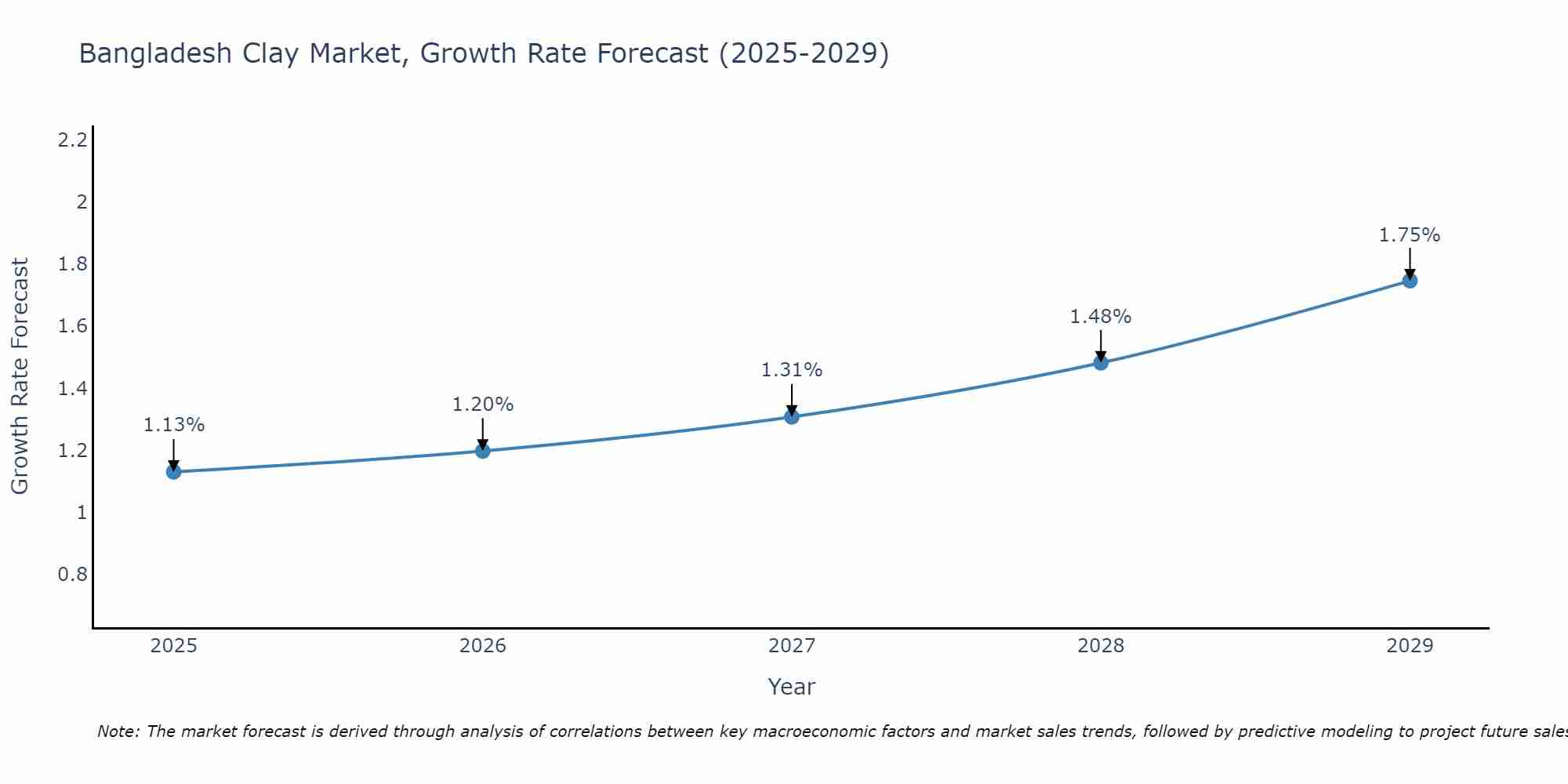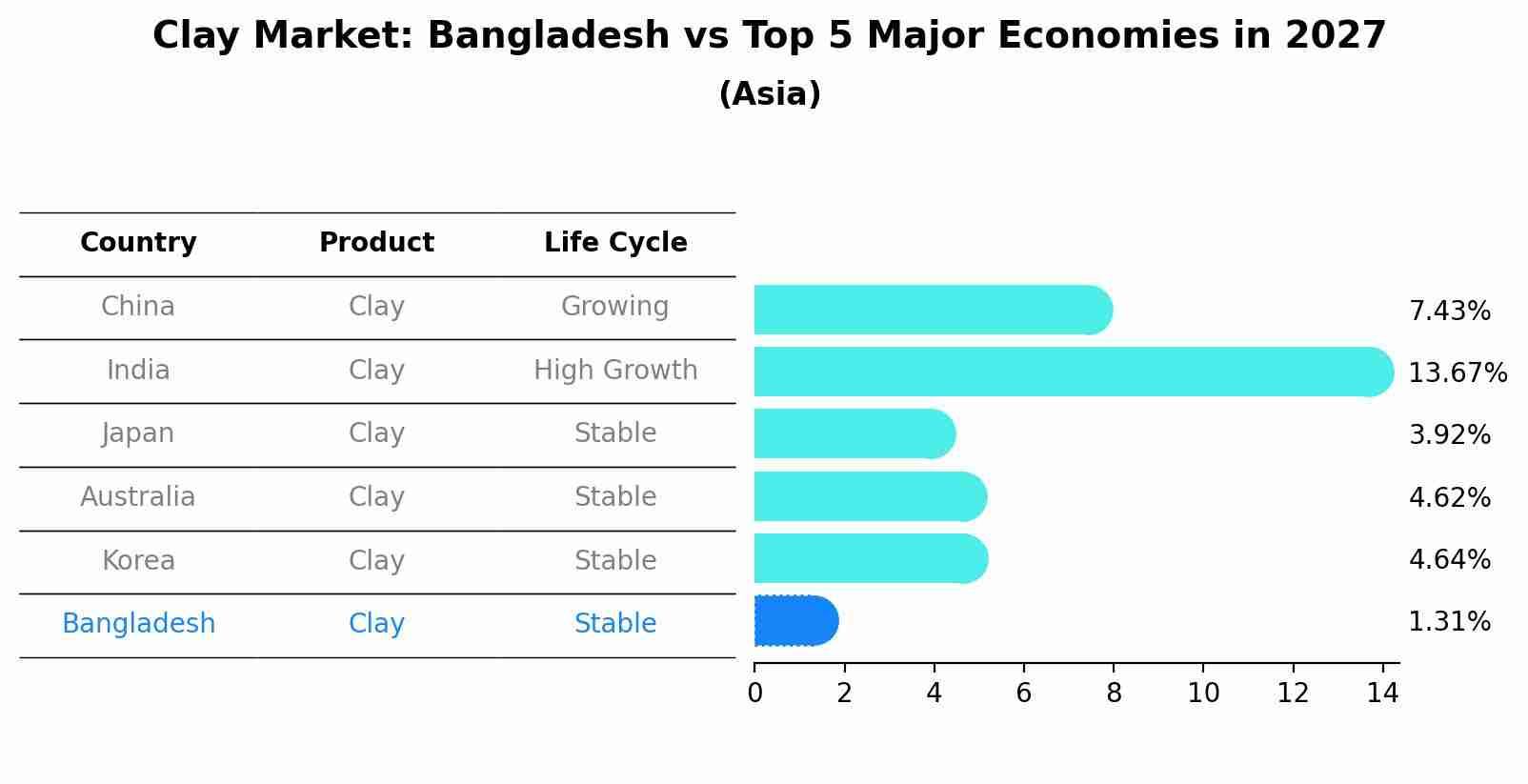Bangladesh Clay Market (2025-2031) Outlook | Revenue, Size, Analysis, Value, Forecast, Trends, Industry, Companies, Growth & Share
| Product Code: ETC318992 | Publication Date: Aug 2022 | Updated Date: Aug 2025 | Product Type: Market Research Report | |
| Publisher: 6Wresearch | Author: Shubham Padhi | No. of Pages: 75 | No. of Figures: 35 | No. of Tables: 20 |
Bangladesh Clay Market Size Growth Rate
The Bangladesh Clay Market is poised for steady growth rate improvements from 2025 to 2029. From 1.13% in 2025, the growth rate steadily ascends to 1.75% in 2029.

Clay Market: Bangladesh vs Top 5 Major Economies in 2027 (Asia)
By 2027, Bangladesh's Clay market is forecasted to achieve a stable growth rate of 1.31%, with China leading the Asia region, followed by India, Japan, Australia and South Korea.

Bangladesh Clay Market Overview
In Bangladesh, the clay market has witnessed steady growth owing to its extensive use in various industries such as construction, ceramics, and refractories. The demand for clay products and refractories remains robust due to ongoing infrastructure development projects and the flourishing construction sector. Moreover, the market for clay refractories specifically caters to the needs of industries requiring high-temperature resistance materials, such as steel, cement, and glass.
Drivers of the market
In Bangladesh, the clay market is experiencing robust growth due to increasing demand from construction and infrastructure projects. With the government`s focus on infrastructure development and urbanization initiatives, the demand for clay products such as bricks, tiles, and refractories is on the rise. Additionally, the growing emphasis on sustainable construction materials is driving market growth, as clay products are considered eco-friendly and durable.
Challenges of the market
Bangladesh clay market, while vibrant, faces hurdles related to infrastructure and logistics. The transportation of clay and finished products can be hampered by inadequate roads and inefficient supply chains, leading to delays and increased costs. Moreover, inconsistent quality standards and competition from imported clay products pose challenges for local manufacturers.
Government Policy of the market
In Bangladesh, the clay market plays a pivotal role in various industries, including construction and manufacturing. The government has implemented policies to support the sustainable growth of this sector, focusing on promoting environmentally friendly practices and ensuring the availability of quality clay products at competitive prices. Additionally, initiatives such as training programs for artisans and modernization efforts in production techniques aim to enhance the efficiency and competitiveness of the Bangladesh clay market.
Key Highlights of the Report:
- Bangladesh Clay Market Outlook
- Market Size of Bangladesh Clay Market, 2024
- Forecast of Bangladesh Clay Market, 2031
- Historical Data and Forecast of Bangladesh Clay Revenues & Volume for the Period 2021-2031
- Bangladesh Clay Market Trend Evolution
- Bangladesh Clay Market Drivers and Challenges
- Bangladesh Clay Price Trends
- Bangladesh Clay Porter's Five Forces
- Bangladesh Clay Industry Life Cycle
- Historical Data and Forecast of Bangladesh Clay Market Revenues & Volume By Application for the Period 2021-2031
- Historical Data and Forecast of Bangladesh Clay Market Revenues & Volume By Tableware for the Period 2021-2031
- Historical Data and Forecast of Bangladesh Clay Market Revenues & Volume By Sanitary ware for the Period 2021-2031
- Historical Data and Forecast of Bangladesh Clay Market Revenues & Volume By Medical applications for the Period 2021-2031
- Historical Data and Forecast of Bangladesh Clay Market Revenues & Volume By End Use for the Period 2021-2031
- Historical Data and Forecast of Bangladesh Clay Market Revenues & Volume By Ceramic and for the Period 2021-2031
- Historical Data and Forecast of Bangladesh Clay Market Revenues & Volume By Non-ceramic for the Period 2021-2031
- Bangladesh Clay Import Export Trade Statistics
- Market Opportunity Assessment By Application
- Market Opportunity Assessment By End Use
- Bangladesh Clay Top Companies Market Share
- Bangladesh Clay Competitive Benchmarking By Technical and Operational Parameters
- Bangladesh Clay Company Profiles
- Bangladesh Clay Key Strategic Recommendations
Frequently Asked Questions About the Market Study (FAQs):
1 Executive Summary |
2 Introduction |
2.1 Key Highlights of the Report |
2.2 Report Description |
2.3 Market Scope & Segmentation |
2.4 Research Methodology |
2.5 Assumptions |
3 Bangladesh Clay Market Overview |
3.1 Bangladesh Country Macro Economic Indicators |
3.2 Bangladesh Clay Market Revenues & Volume, 2021 & 2031F |
3.3 Bangladesh Clay Market - Industry Life Cycle |
3.4 Bangladesh Clay Market - Porter's Five Forces |
3.5 Bangladesh Clay Market Revenues & Volume Share, By Application, 2021 & 2031F |
3.6 Bangladesh Clay Market Revenues & Volume Share, By End Use, 2021 & 2031F |
4 Bangladesh Clay Market Dynamics |
4.1 Impact Analysis |
4.2 Market Drivers |
4.2.1 Growth in the construction industry in Bangladesh leading to increased demand for clay for bricks and tiles. |
4.2.2 Government initiatives and investments in infrastructure development projects driving the demand for clay-based products. |
4.2.3 Favorable economic conditions and increasing urbanization boosting the construction activities requiring clay materials. |
4.3 Market Restraints |
4.3.1 Environmental concerns related to clay extraction and processing leading to regulatory challenges. |
4.3.2 Fluctuations in clay prices due to supply chain disruptions or changes in import/export policies. |
5 Bangladesh Clay Market Trends |
6 Bangladesh Clay Market, By Types |
6.1 Bangladesh Clay Market, By Application |
6.1.1 Overview and Analysis |
6.1.2 Bangladesh Clay Market Revenues & Volume, By Application, 2021-2031F |
6.1.3 Bangladesh Clay Market Revenues & Volume, By Tableware, 2021-2031F |
6.1.4 Bangladesh Clay Market Revenues & Volume, By Sanitary ware, 2021-2031F |
6.1.5 Bangladesh Clay Market Revenues & Volume, By Medical applications, 2021-2031F |
6.2 Bangladesh Clay Market, By End Use |
6.2.1 Overview and Analysis |
6.2.2 Bangladesh Clay Market Revenues & Volume, By Ceramic and, 2021-2031F |
6.2.3 Bangladesh Clay Market Revenues & Volume, By Non-ceramic, 2021-2031F |
7 Bangladesh Clay Market Import-Export Trade Statistics |
7.1 Bangladesh Clay Market Export to Major Countries |
7.2 Bangladesh Clay Market Imports from Major Countries |
8 Bangladesh Clay Market Key Performance Indicators |
8.1 Average selling price of clay products. |
8.2 Number of infrastructure projects using clay-based materials. |
8.3 Percentage of clay extracted through sustainable practices. |
8.4 Adoption rate of new technologies in clay processing. |
8.5 Customer satisfaction levels with clay products. |
9 Bangladesh Clay Market - Opportunity Assessment |
9.1 Bangladesh Clay Market Opportunity Assessment, By Application, 2021 & 2031F |
9.2 Bangladesh Clay Market Opportunity Assessment, By End Use, 2021 & 2031F |
10 Bangladesh Clay Market - Competitive Landscape |
10.1 Bangladesh Clay Market Revenue Share, By Companies, 2024 |
10.2 Bangladesh Clay Market Competitive Benchmarking, By Operating and Technical Parameters |
11 Company Profiles |
12 Recommendations |
13 Disclaimer |
- Single User License$ 1,995
- Department License$ 2,400
- Site License$ 3,120
- Global License$ 3,795
Search
Related Reports
- ASEAN and Thailand Brain Health Supplements Market (2025-2031) | Strategy, Consumer Insights, Analysis, Investment Trends, Opportunities, Growth, Size, Share, Industry, Revenue, Segments, Value, Segmentation, Supply, Forecast, Restraints, Outlook, Competition, Drivers, Trends, Demand, Pricing Analysis, Competitive, Strategic Insights, Companies, Challenges
- ASEAN Bearings Market (2025-2031) | Strategy, Consumer Insights, Analysis, Investment Trends, Opportunities, Growth, Size, Share, Industry, Revenue, Segments, Value, Segmentation, Supply, Forecast, Restraints, Outlook, Competition, Drivers, Trends, Demand, Pricing Analysis, Competitive, Strategic Insights, Companies, Challenges
- Europe Flooring Market (2025-2031) | Outlook, Share, Industry, Trends, Forecast, Companies, Revenue, Size, Analysis, Growth & Value
- Saudi Arabia Manlift Market (2025-2031) | Outlook, Size, Growth, Trends, Companies, Industry, Revenue, Value, Share, Forecast & Analysis
- Uganda Excavator, Crane, and Wheel Loaders Market (2025-2031) | Strategy, Consumer Insights, Analysis, Investment Trends, Opportunities, Growth, Size, Share, Industry, Revenue, Segments, Value, Segmentation, Supply, Forecast, Restraints, Outlook, Competition, Drivers, Trends, Demand, Pricing Analysis, Competitive, Strategic Insights, Companies, Challenges
- Rwanda Excavator, Crane, and Wheel Loaders Market (2025-2031) | Strategy, Consumer Insights, Analysis, Investment Trends, Opportunities, Growth, Size, Share, Industry, Revenue, Segments, Value, Segmentation, Supply, Forecast, Restraints, Outlook, Competition, Drivers, Trends, Demand, Pricing Analysis, Competitive, Strategic Insights, Companies, Challenges
- Kenya Excavator, Crane, and Wheel Loaders Market (2025-2031) | Strategy, Consumer Insights, Analysis, Investment Trends, Opportunities, Growth, Size, Share, Industry, Revenue, Segments, Value, Segmentation, Supply, Forecast, Restraints, Outlook, Competition, Drivers, Trends, Demand, Pricing Analysis, Competitive, Strategic Insights, Companies, Challenges
- Angola Excavator, Crane, and Wheel Loaders Market (2025-2031) | Strategy, Consumer Insights, Analysis, Investment Trends, Opportunities, Growth, Size, Share, Industry, Revenue, Segments, Value, Segmentation, Supply, Forecast, Restraints, Outlook, Competition, Drivers, Trends, Demand, Pricing Analysis, Competitive, Strategic Insights, Companies, Challenges
- Israel Intelligent Transport System Market (2025-2031) | Strategy, Consumer Insights, Analysis, Investment Trends, Opportunities, Growth, Size, Share, Industry, Revenue, Segments, Value, Segmentation, Supply, Forecast, Restraints, Outlook, Competition, Drivers, Trends, Demand, Pricing Analysis, Competitive, Strategic Insights, Companies, Challenges
- Uganda Precast and Aggregate Market (2025-2031) | Strategy, Consumer Insights, Analysis, Investment Trends, Opportunities, Growth, Size, Share, Industry, Revenue, Segments, Value, Segmentation, Supply, Forecast, Restraints, Outlook, Competition, Drivers, Trends, Demand, Pricing Analysis, Competitive, Strategic Insights, Companies, Challenges
Industry Events and Analyst Meet
Our Clients
Whitepaper
- Middle East & Africa Commercial Security Market Click here to view more.
- Middle East & Africa Fire Safety Systems & Equipment Market Click here to view more.
- GCC Drone Market Click here to view more.
- Middle East Lighting Fixture Market Click here to view more.
- GCC Physical & Perimeter Security Market Click here to view more.
6WResearch In News
- Doha a strategic location for EV manufacturing hub: IPA Qatar
- Demand for luxury TVs surging in the GCC, says Samsung
- Empowering Growth: The Thriving Journey of Bangladesh’s Cable Industry
- Demand for luxury TVs surging in the GCC, says Samsung
- Video call with a traditional healer? Once unthinkable, it’s now common in South Africa
- Intelligent Buildings To Smooth GCC’s Path To Net Zero













